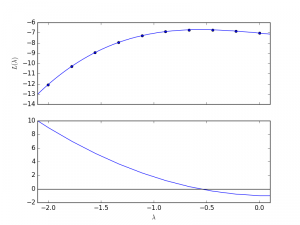(work in progress)
Many convex optimization problems can be solved, fairly simply, if the projection onto the constraints can be quickly and simply calculated. By projection onto the constraints ![]() , we mean the solution to the following optimization problem:
, we mean the solution to the following optimization problem:
(1) ![]()
As an example, the subgradient descent method can incorporate the projection operator to deal with constraints. Here we focus on projection on a simplex: ![]() . The objective function that we wish to solve is:
. The objective function that we wish to solve is:
(2) 
As a test case, we can implement the projection in cvxpy:
import cvxpy as cvx
import numpy as np
def proj_simplex_cvxpy(a, y):
'''
Returns the point in the simplex a^Tx = 1, x>=0 that is
closest to y (according to Euclidian distance)
'''
d = len(a)
# setup the objective and constraints and solve the problem
x = cvx.Variable(d)
obj = cvx.Minimize(cvx.sum_squares(x - y))
constr = [x >= 0, a*x == 1]
prob = cvx.Problem(obj, constr)
prob.solve()
return np.array(x.value).squeeze()
We can write the dual as:
![Rendered by QuickLaTeX.com \begin{align*} L(\lambda) & = \min_{x} \sum_{i=1}^{n}\left[\frac{1}{2}(x_i - y_i)^2 + \lambda a_i x_i \right] -\lambda\qquad \textrm{s.t.} \quad x \succeq 0, \\ & =\min_{x} \sum_{i=1}^{n}\left[\frac{1}{2}x_i^2 - x_i[y_i - \lambda a_i]- \frac{1}{2}y_i^2\right] - \lambda \qquad \textrm{s.t.} \quad x \succeq 0. \end{align*}](http://www.mcduplessis.com/wp-content/ql-cache/quicklatex.com-ec69243cdbdcd49401aaa472a9e2eaa1_l3.png)
Since the ![]() decouples (for fixed
decouples (for fixed ![]() ) it can be solved as:
) it can be solved as:
![]()
The dual objective (which is to be maximized) is therefore:

An example of the dual function is given below (source code is here):
As ![]() is decreased from a large value, the values of
is decreased from a large value, the values of ![]() will “switch on” from
will “switch on” from ![]() . To determine where the variables will switch on we sort the values according to
. To determine where the variables will switch on we sort the values according to ![]() .
.
Consider that we have an index ![]() that sorts according to
that sorts according to ![]() . In other words:
. In other words:
![]()
We can refer to these as our indexed ![]() values,
values,
![]()
Suppose that we have a ![]() value. We then want to find an index
value. We then want to find an index ![]() , so that
, so that
![]()
We can then write the objective function as:

The derivative of the above is therefore:

By searching on the sorted list, we get an index ![]() , such that
, such that ![]() , but
, but ![]() .
.
The optimal lambda value can then be calculated as:
![]()
The final algorithm is:
def proj(a, y):
l = y/a
idx = np.argsort(l)
d = len(l)
evalpL = lambda k: np.sum(a[idx[k:]]*(y[idx[k:]] - l[idx[k]]*a[idx[k:]]) ) -1
def bisectsearch():
idxL, idxH = 0, d-1
L = evalpL(idxL)
H = evalpL(idxH)
if L<0:
return idxL
while (idxH-idxL)>1:
iMid = int((idxL+idxH)/2)
M = evalpL(iMid)
if M>0:
idxL, L = iMid, M
else:
idxH, H = iMid, M
return idxH
k = bisectsearch()
lam = (np.sum(a[idx[k:]]*y[idx[k:]])-1)/np.sum(a[idx[k:]])
x = np.maximum(0, y-lam*a)
return x
Other resources:
- MATLAB implementation of projection onto unit simplex (description here)
- Michelot, C. (1986). A finite algorithm for finding the projection of a point onto the canonical simplex of∝ n. Journal of Optimization Theory and Applications, 50(1), 195-200.
Todo:
- Implement the code in C/C++
- Give a better test case
- Simplify the explanation and implementation
- Give a practical example (e.g. estimation problem with subgradient descent)
